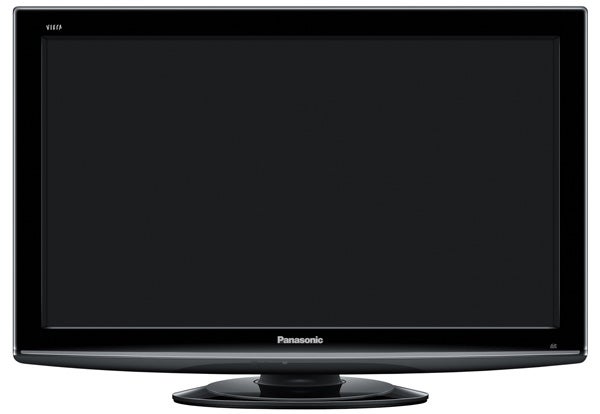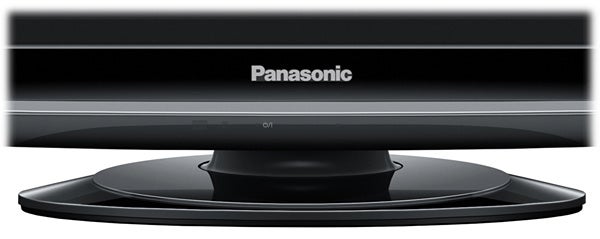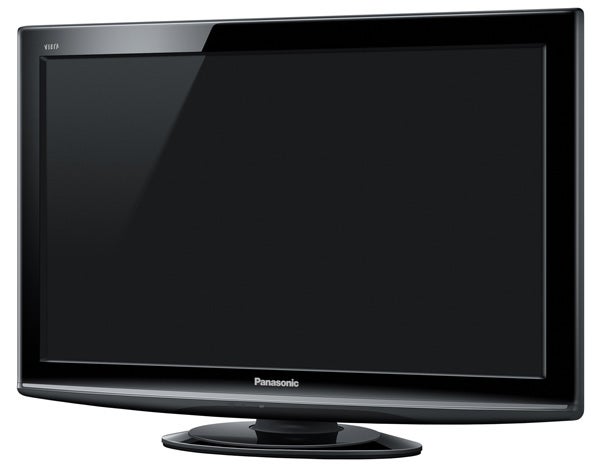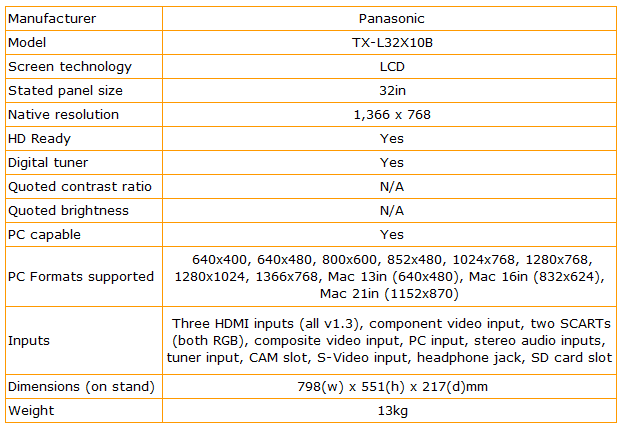Panasonic Viera TX-L32X10 32in LCD TV Review
Panasonic Viera TX-L32X10 32in LCD TV
It's not perfect, but if money's tight Panasonic's TX-L32X10 32in LCD TV is worth at least an audition.

Verdict
Key Specifications
- Review Price: £599.99
Earlier in the week we got the chance to check out the first of Panasonic’s new plasma TVs, the P37X10, and came away mostly impressed. Now we’ve got our hands on the first of Panasonic’s new LCD TVs. And our final feelings about it are broadly similar, if not quite so enthusiastic.
The similarities begin with the 32in TX-L32X10’s design – not a particularly great thing, actually, as I find the current Panasonic design approach a little on the bland side. Probably the best thing you can say about the black rectangular design, with its somehow rather clumsy angled-forward section along the bottom edge, is that it’s understated.
The L32X10’s connections are identical to those of the P37X10 too. Which is really as I would have expected given that, as the X10 part of their names suggests, both TVs are from the same, relatively low-end series within the latest – huge – Panasonic hierarchy.
To save you having to revisit last week’s plasma review, the highlights of the connections are three HDMIs, a D-Sub PC port, and an SD card slot via which the TV can play JPEG stills, but not the AVCHD video format supported by the SD card readers on some of Panasonic’s higher-spec new models.
The relatively low level of the L32X10 is also reflected in its native resolution, as we find an HD Ready 1,366 x 768 rather than the Full HD 1,920 x 1,080 that’s starting to appear increasingly commonly at the 32in level. What’s more, the set doesn’t manage any major motion-enhancement processing, be it Panasonic’s Intelligent Frame Creation or a 100Hz system. Hopefully this won’t cause major issues with the L32X10’s performance.
A typically excellent Panasonic remote control and some clear if not particularly stylish onscreen menus continue the rather stripped down theme, presenting precious little for me to get excited about. Probably the single most notable thing, as with the P37X10, is the addition of a new Viera Tools button on the remote that calls up four icon shortcuts to the set’s Viera Link and photo-viewing capabilities.
Viera Link, in case you’re not familiar with it, is Panasonic’s name for its system of enhanced communication between Panasonic devices connected via HDMI cables. For instance, thanks to Viera Link, if you’ve got a Panasonic digital recorder hooked up to the L32X10 you can instantly record anything you’re watching just by pressing a single button on the remote control.
Otherwise the only notable features are an Eco mode that adjusts the image’s brightness in response to the amount of light measured in your room; an optimistically named ‘Colour Management’ option that actually just makes pictures look more vivid; and a basic noise reduction tool.
With nothing else to detain me, then, I might as well get straight down to business with the L32X10’s pictures. Which are best summed up as decent for the money, but certainly not state of the art.
Arguably their greatest – and in many ways most surprising – strength is how crisp HD pictures look. Yet another day spent in the company of the seemingly endless England/West Indies cricket tour shown in HD on Sky reveals visible cracks and bumps in the outfield that you just don’t see with standard definition or lower-quality HD screens. This is particularly impressive considering that the screen is HD Ready rather than Full HD, and proves for the umpteenth time that Panasonic’s core scaling processing is a cut above that of most other brands.
This processing leads to another strength too: really respectable standard definition pictures that look sharper, cleaner and more authentically colour toned than we commonly see with LCD TVs. Especially those at the £600 or less price point. 
Of course, all this talk of sharpness wouldn’t likely have taken place if I’d found myself ruing the absence of 100Hz processing as badly as I’d feared. But in fact the screen doesn’t smear very severely at all, even without much processing help. Sure, the cricket ball loses SOME resolution as it races across the pitch, as does the picture generally during rapid camera pans. But the problem isn’t severe by any means, and leaves the L32X10 a clear cut above the seriously smeary efforts that spoil so many of the budget brands sitting below it.
I also ultimately liked the L32X10’s colour performance, despite initial reservations. These reservations come about from the fact that colour tones aren’t as outrageously vibrant and aggressive as we’ve seen them on some rival – usually more expensive – TVs. But more extended viewing made me realise that while not spectacularly intense, colours are at least solid and mostly likeably natural in tone. Skin tones fare particularly well, with even standard definition ones looking detailed and largely free of the common ‘waxy’ look. Only an occasional slightly muted and/or radioactive green tone lets the side down.
Yet another strength of the L32X10 concerns its viewing angle, for I found neither colour nor contrast to drop off as badly as expected when I started moving around the room.
Turning to things I’m not so keen on in the L32X10’s pictures, the first concerns its black level response. It’s not actually bad, especially compared with much of the budget competition. But at the same time, dark scenes are still clearly affected by a degree of the tell-tale grey clouding problem, especially if there are any bright elements within a generally dark frame.
The L32X10 carries a dynamic contrast system that reduces the backlight output during dark scenes to boost black level depth. But as well as not being able to completely over-ride the greying problem as much as I’d like, the dynamic contrast tool also sometimes causes distracting ‘jumps’ or shifts in the image’s overall brightness level.
I also found the backlight level a little inconsistent, with a couple of areas around the screen’s edges being slightly brighter than the rest of the picture. Before you get too alarmed by this, though, it’s a subtle enough problem to be seldom noticeable during anything but the very darkest scenes. It’s certainly nothing like as pronounced as it is on Sony’s infamous W4500 TVs.
While the L32X10’s pictures generally do a pretty bang up job of hiding its affordable nature, though, it fares less well sonically. Too much of the soundstage is crammed into a pretty limited mid-range, leaving things sounding slightly muffled and artificial when the going gets tough.
There’s no great sense of depth or width to the soundstage either, meaning the audio experience doesn’t really expand your experience beyond the confines of the screen’s borders.
”’Verdict”’
Despite a couple of significant flaws, the L32X10’s pictures overall rate as good for the TV’s price point. So if money’s tight but you’re just not prepared to put up with the general grubbiness witnessed with the spate of ultra-cheap ‘no-brand’ LCD models we’ve looked at recently, the L32X10 is definitely worth at least an audition. Especially if you can partner it with some sort of external sound system.

How we test televisions
We test every TV we review thoroughly over an extended period of time. We use industry standard tests to compare features properly. We’ll always tell you what we find. We never, ever, accept money to review a product.
Trusted Score
Score in detail
-
Features 6
-
Value 8
-
Image Quality 8
-
Design 6
-
Sound Quality 6
Features
| Size (Inch) | 32in |
| Display Type | LCD |

